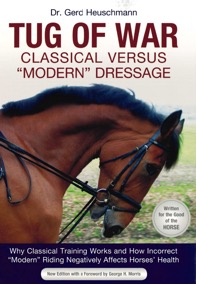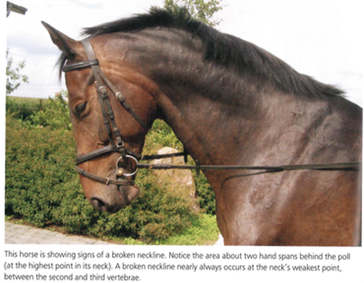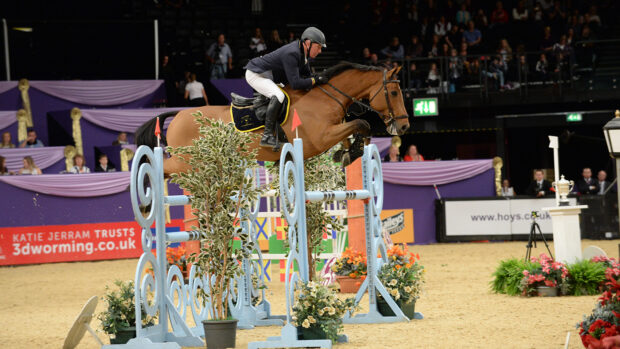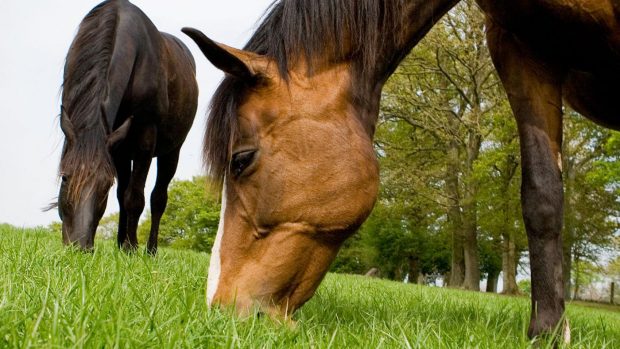Tug of War: Classical Versus ‘Modern’ Dressage — Why Classic Training Works and How Incorrect ‘Modern’ Riding Negatively Affects Horses’ Health is a new book written by German rider and equine veterinarian Dr. Gerd Heuschmann, who is well-known in dressage circles. He is admired by many for his plain speaking regarding what he deems the incorrect and damaging training methods commonly employed by some riders and trainers involved in competition today.
Here, he presents an intelligent and thought-provoking exploration of both classical and ‘modern’ training methods, including ‘hyperflexion’ (also known as Rollkur), against a practical backdrop of the horse’s basic anatomy and physiology.
This book is described as addressing the following areas:
- Riders — to use only gentle, progressive training methods in accordance with the time-tested principles of classical riding.
- Judges — to sharpen their eyes and recognise unnatural postures or forced movements and evaluate them accordingly in competition, while rewarding classically trained, correctly gymnasticised horses.
- Governing organisations — to review their regulations and uphold stipulated ‘ideals’ on both national and international levels.
- Spectators — to reject sensational performances and flashy tests when the methods used to obtain them have not had the health and welfare of the horse in mind.
Dr Gerd Heuschmann trained as a Bereiter (master rider) in Germany before qualifying for veterinary study at Munich University. He accepted a post as the head of the breeding department at the German FN (German Equestrian Federation), which he eventually left to start his own practice in Warendorf. Along with Klaus Balkenhol, and other prominent figures in the dressage community, Dr Heuschmann is a founding member of ‘Xenophon’, an organisation dedicated to “fighting hard against serious mistakes in equestrian sport”.
Tug of War: Classical Versus ‘Modern’ Dressage is a thought-provoking exploration of training methods in dressage, which will appeal to those involved in any sort of equestrian training. It is also fully illustrated with 80 colour photographs and 15 colour line artworks.
In this book extract, Dr. Gerd Heuschmann explains the ‘broken’ neckline:
 Many riders are familiar with the sight of a horse on the bit where the upper neckline is ‘broken’ at a point about two hand spans behind the poll: the upper neckline no longer runs in an even curve. Every experienced rider knows that this is undesirable — even bad — and is usually created by excessive pulling on the reins. You may ask why it is that the neckline always ‘breaks’ in the same spot. And why is it so difficult to eliminate this problem through training?
Many riders are familiar with the sight of a horse on the bit where the upper neckline is ‘broken’ at a point about two hand spans behind the poll: the upper neckline no longer runs in an even curve. Every experienced rider knows that this is undesirable — even bad — and is usually created by excessive pulling on the reins. You may ask why it is that the neckline always ‘breaks’ in the same spot. And why is it so difficult to eliminate this problem through training?
Chapter three introduced you to the muscle groups that are important in riding. You learned that the cervical spine is maintained in its curved S-form by the laminar portion of the neck (lamina nuchae) and the M. splenius cervicis, especially at the part nearest the withers. From other insights gained there (especially about the connection between head, neck and back) you can conclude that a neck lowered in relaxation opens up in a forward and downward direction, especially in the curved part of the cervical spine nearest the withers, thereby playing the key role in lifting the back through ligamentous and muscular apparatus.

In contrast, a horse whose back is stiff and tense cannot bring this curved section of the cervical spine into the desired stretch because the tense neck muscles and the tightly set ligament system literally hold this part of the cervical spine rigid. If the rider generates such a head set with strong hand influence, the neck is not able to bend appropriately, and the cervical spine ‘breaks’ along its weakest part.

The occipital bone of the skull, as well as the first and second neck vertebra are connected through a solid muscle system. The M. rectus capitis with its various parts and the M. obliquus capitis with its two parts connect these three boney structures strongly and firmly. As a consequence, the ‘broken neckline’ occurs at the joint with the smallest resistance, between the second and third vertebra. You can eliminate this only if you can manage to loosen up and relax the longis-simus back muscle and respective muscles of the upper neck. Only then can you create rhythmically pure ‘forwardness’ in all three basic gaits.
Price: Tug of War: Classical Versus ‘Modern’ Dressage can be purchased for £18.99 via Amazon.
Published by: The Crowood Press, 2018
For all the latest equestrian news and reports, don’t miss Horse & Hound magazine out every Thursday




